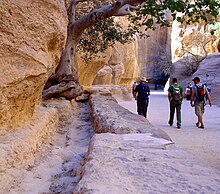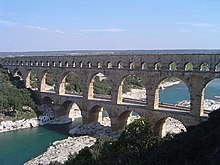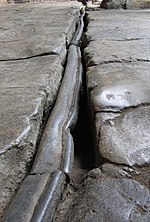m →Ancient plumbing systems: WP:CHECKWIKI error fix for #61. Punctuation goes before References. Do general fixes if a problem exists. - using AWB (9774) |
94.7.175.163 (talk) |
||
| Line 9: | Line 9: | ||
==Prehistory== |
==Prehistory== |
||
During the [[Neolithic]], man dug the first permanent [[water well]]s, from where vessels could be filled and carried by hand. Wells dug around 6500 BCE have been found in the [[Jezreel Valley]].<ref>http://www.haaretz.com/news/national/ancient-well-reveals-secrets-of-first-jezreel-valley-farmers-1.476288</ref> [[Stepwell]]s have mainly been used in South Asia. The size of human settlements was largely dependent on nearby available water. [[Pit toilet]]s and [[chamber pot]]s were the only alternative to [[defecation]] in the open. Devices such as [[shadoof]]s, and [[sakia]]s were used to lift water to ground level. |
During the [[Neolithic]], man dug the first permanent [[water well]]s, from where vessels could be filled and carried by hand. Wells dug around 6500 BCE have been found in the [[Jezreel Valley]].<ref>http://www.haaretz.com/news/national/ancient-well-reveals-secrets-of-first-jezreel-valley-farmers-1.476288</ref> [[Stepwell]]s have mainly been used in South Asia. The size of human settlements was largely dependent on nearby available water. [[Pit toilet]]s and [[chamber pot]]s were the only alternative to [[defecation]] in the open. Devices such as [[shadoof]]s, and [[sakia]]s were used to lift water to ground level. Mohenjo-daro ruins in Pakistan, part of the Indus Valley Civilization, shows that the city had one of the world's most ancient sophisticated sewerage system that contained drainage channels and street ducts.<ref>Mughal, Muhammad Aurang Zeb. 2011. [http://ebooks.abc-clio.com/print.aspx?isbn=9781851099344&id=A1725C-1520 Mohenjo-daro’s Sewers]. In Kevin Murray McGeough (ed.), ''World History Encyclopedia'', Vol. 3. Santa Barbara, CA: ABC-CLIO, pp. 121-122.</ref> |
||
==Ancient plumbing systems== |
==Ancient plumbing systems== |
||
Revision as of 21:55, 29 December 2013






Water supply, plumbing, sanitation, and sewage collection and disposal have been primary logistical challenges since the dawn of civilization. Where water resources or infrastructure are insufficient for the population, people fall prey to disease, dehydration, and in extreme cases, starvation. Major human settlements could initially develop only where fresh surface water was plentiful, such as near major rivers. Over the millennia, technology has dramatically increased the distances across which water can be relocated, but the availability of clean and fresh water remains a limiting factor on the size and density of population centers, and is expected to remain so into the foreseeable future.
Prehistory
During the Neolithic, man dug the first permanent water wells, from where vessels could be filled and carried by hand. Wells dug around 6500 BCE have been found in the Jezreel Valley.[1] Stepwells have mainly been used in South Asia. The size of human settlements was largely dependent on nearby available water. Pit toilets and chamber pots were the only alternative to defecation in the open. Devices such as shadoofs, and sakias were used to lift water to ground level. Mohenjo-daro ruins in Pakistan, part of the Indus Valley Civilization, shows that the city had one of the world's most ancient sophisticated sewerage system that contained drainage channels and street ducts.[2]
Ancient plumbing systems
- See also Sanitation in the Indus Valley Civilization, Sanitation in Ancient Rome, and Traditional water sources of Persian antiquity.
Throughout history people have devised systems to make getting and using water more convenient. The Indus Valley Civilization has early evidence of public water supply and sanitation. The Indians were the first to use indoor plumbing.[3] The ancient Greek civilization of Crete, known as the Minoan civilization, was the first civilization to use underground clay pipes for sanitation and water supply.[4][5] Their capital, Knossos, had a well organized water system for bringing in clean water, taking out waste water and storm sewage canals for overflow when there was heavy rain. It was also one of the first uses of a flush toilet, dating back to 18th century BC.[6] In addition to sophisticated water and sewer systems they devised elaborate heating systems. The Ancient Greeks of Athens and Asia Minor also used an indoor plumbing system, used for pressurized showers.[7] The Greek inventor Heron used pressurized piping for fire fighting purposes in the City of Alexandria.[8] The Mayans were the third earliest civilization to have employed a system of indoor plumbing using pressurized water.[9] The Roman Empire had indoor plumbing, meaning a system of aqueducts and pipes that terminated in homes and at public wells and fountains for people to use. Rome and other nations used lead pipes; while commonly thought to be the cause of lead poisoning in the Roman Empire, the combination of running water which did not stay in contact with the pipe for long and the deposition of precipitation scale actually mitigated the risk from lead pipes.[10][11]
Persian Qanats have been used for water supply and cooling in the Middle East.
Middle and early modern age

Pail closets, outhouses, and cesspits were used to collect human waste. The use of human waste as fertilizer was especially important in China and Japan, where cattle manure was less available. See toilets in Japan. After the adoption of gunpowder, municipal outhouses became an important source of raw material for the making of saltpeter in European countries.[12]
In London, the contents of the city's outhouses were collected every night by commissioned wagons and delivered to the nitrite beds where it was sown into the special soil beds to produce earth rich in mineral nitrates. The nitrate rich-earth is then further processed to produce saltpeter, or potassium nitrate, an important ingredient in black powder.[13]
London water supply infrastructure developed over many centuries from early mediaeval conduits, through major 19th century treatment works built in response to cholera threats, to modern large scale reservoirs. The trap was invented in 1775. Fire hydrants were introduced in the 18th and 19th century.
Industrial age
The first screw-down water tap was patented in 1845. The germ theory of disease emphasized the need of clean water supply, separated from sewerage. The 1854 Broad Street cholera outbreak in London was a well-known case.
Water towers appeared around the late 19th century, as building height rose, and steam, electric and diesel-powered water pumps became available. As skyscrapers appeared, they needed rooftop water towers.
The technique of purification of drinking water by use of compressed liquefied chlorine gas was developed in 1910 by U.S. Army Major (later Brig. Gen.) Carl Rogers Darnall (1867–1941), Professor of Chemistry at the Army Medical School. Shortly thereafter, Major (later Col.) William J. L. Lyster (1869–1947) of the Army Medical Department used a solution of calcium hypochlorite in a linen bag to treat water. For many decades, Lyster's method remained the standard for U.S. ground forces in the field and in camps, implemented in the form of the familiar Lyster Bag (also spelled Lister Bag). Darnall's work became the basis for present day systems of municipal water purification.
The first successful district heating system was introduced in Lockport, New York, in 1877.
Current development
During the beginning of the 21st Century, especially in areas of urban and suburban population centres, traditional centralized infrastructure have not been able to supply sufficient quantities of water to keep up with growing demand. Among several options that have been managed are the extensive use of desalination technology, this is especially prevalent in coastal areas and in "dry" countries like Australia. Decentralization of water infrastructure has grown extensively as a viable solution including rainwater harvesting and stormwater harvesting where policies are eventually tending towards a more rational use and sourcing of water incorporation concepts such as "Fit for Purpose".
Fresh water is an objective among the Millennium Development Goals.
See also
References
- ^ http://www.haaretz.com/news/national/ancient-well-reveals-secrets-of-first-jezreel-valley-farmers-1.476288
- ^ Mughal, Muhammad Aurang Zeb. 2011. Mohenjo-daro’s Sewers. In Kevin Murray McGeough (ed.), World History Encyclopedia, Vol. 3. Santa Barbara, CA: ABC-CLIO, pp. 121-122.
- ^ http://en.wikipedia.org/wiki/3rd_millennium_BC
- ^ http://www.historywiz.com/minoanplumbingandheating.html
- ^ http://www.theplumber.com/crete.html
- ^ http://www.themodernantiquarian.com/site/10854/knossos.html#fieldnotes
- ^ http://web.archive.org/web/20080509052435/http://www.inventions.org/culture/ancient/showers.html
- ^ http://www.smithsonianmag.com/science-nature/ancient_calendar.html
- ^ http://www.sciencedaily.com/releases/2010/05/100504155421.htm
- ^ "Lead Poisoning and Rome". Retrieved 4 June 2013.
- ^ Hodge 1992, p. 308
- ^ Firearms: A Global History to 1700, Kenneth Chase
- ^ Instructions for the Manufacture of Saltpetre, Joseph LeConte, 1823-1901